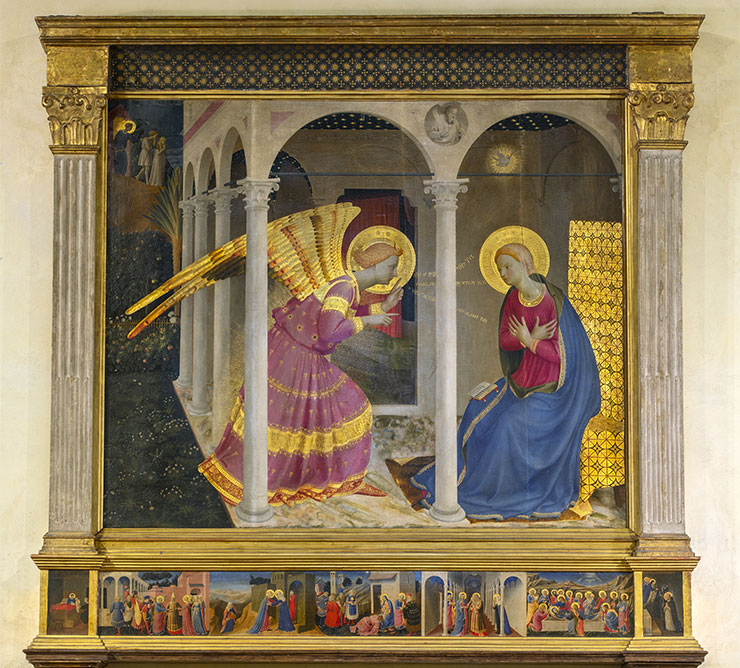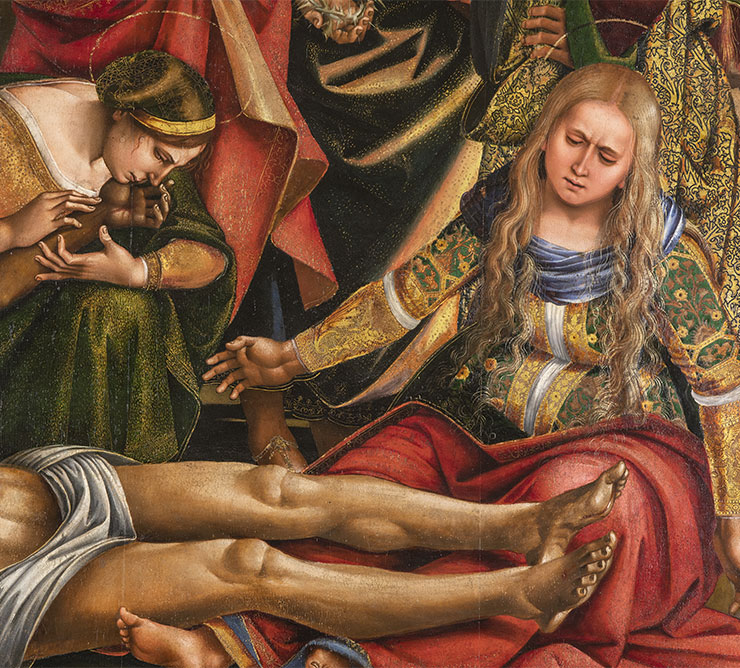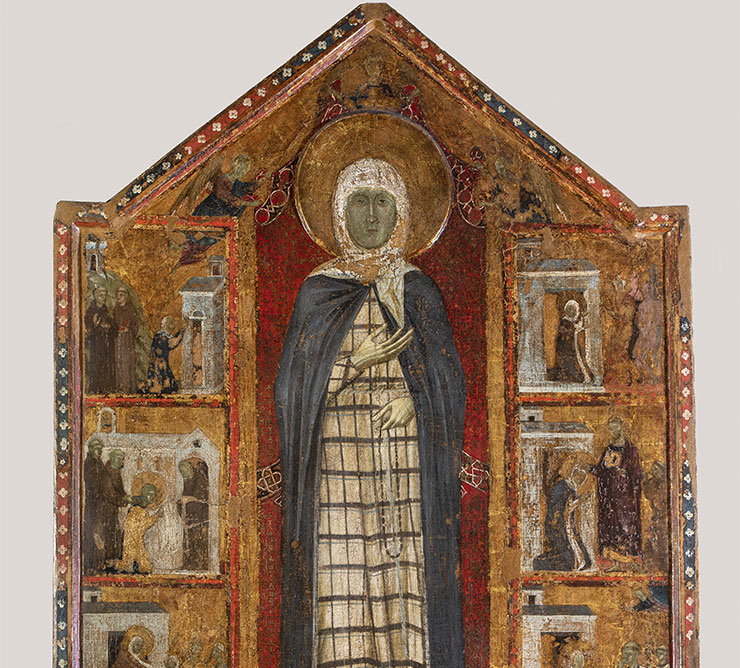In its current form, the cathedral was built in the second half of the 15th century by Giuliano da Sangallo' disciples enclosing the primitive church, as is revealedancient ruins that are visible on the front in concealed stones. On this place, church of Santa Maria Assunta was built, documented as early as 1068, but according to tradition built on an early Christian place of worship.
The Diocesan Museum was inaugurated in 1945 at the desire of Bishop Giuseppe Franciolini and the Cathedral Chapter after over twenty years of work. Already in 1923, on the occasion of the fourth centenary of Luca Signorelli's death, the works of the great master from Cortona had been exhibited here, and in 1939, the collection was enriched with a number of works from the Cathedral and the churches of the Diocese.
Inside the Cathedral, a rich historical-artistic and devotional heritage is preserved. Highlights include the famous painting by Pietro da Cortona representing the Nativity, the marble ciborium attributed to local sculptor Ciuccio di Nuccio, and a ... more
Inside the Cathedral, a rich historical-artistic and devotional heritage is preserved. Highlights include the famous painting by Pietro da Cortona representing the Nativity, the marble ciborium attributed to local sculptor Ciuccio di Nuccio, and a mosaic by Cortona-born Gino Severini depicting the Sacred Heart.
The Diocesan Museum contains paintings on wood and canvas of exceptional interest, and liturgical ornaments, reliquaries and sacred vestments of fine manufacture, testimonies to the art and faith of a very ancient and flourishing community. In particular, these include the Annunciation by Beato Angelico, the Deposition by Signorelli, the Majesty and the large painted Cross by Pietro Lorenzetti, the Assumption by Bartolomeo della Gatta, the Vagnucci Reliquary and the Passerini Vestment, based on designs by Raffaellino del Garbo and Andrea del Sarto.
lessCATHEDRAL:
DIOCESAN MUSEUM:
(last entry 30 minutes before closing time)
By car:
Both from the North and the South, exit the Autostrada del Sole (A1) at the Valdichiana exit. Immediately after the exit, take the E45 motorway (Raccordo Siena-Perugia) towards Perugia and exit at the second exit for Cortona (Cortona San Lorenzo). From here, follow the indications for the SS71 at Camucia and continue on to Cortona.
By train:
With the Florence/Rome railway line, get off at Terontola or Camucia station. With the Terontola Perugia Assisi Terni railway line, get off at Terontola station. From both stations it is easy to reach Cortona by taxi or bus. For timetables and train fares visit the Ferrovie dello Stato website www.trenitalia.com

Considered among the highest masterpieces of the artist and of all Italian Renaissance painting, it is rightly regarded as the highlight of this museum's collection. For it is the most famous and most praised of the three works of the same subject painted by Fra Angelico that have been preserved. The work was commissioned by Giovanni di Cola di Cecco, a textile merchant and member of the Confraternity of St Domenico.
The sacred event represented in the painting takes place within an elegant portico, reminiscent of the architecture designed by Filippo Brunelleschi at the time, and offers depth to the entire work, allowing the painter to place the antecedent to the pivotal episode in the background. In the top left-hand corner are the Progenitors who, driven out of Eden, set out in despair towards the new suffering awaiting redemption, which will be accomplished by Mary, the 'new Eve'. The main scene presents the angel who, having just landed, with the usual stratagem of letters coming out of his mouth like a comic strip, brings the divine announcement. A veritable dialogue develops between the two characters with three verses marked in sequence, with Mary's reply in the middle, written upside down to make the direction of the sentence clear. Traits of finesse are evident throughout the composition: from the borders of the drapery to Mary's seat covered with a gold brocaded cloth, from the figure of Isaiah, prophet of the destiny of salvation, 'sculpted' within a tondo in the centre of the entablature, to the mixed marble floor. Seven scenes from the life of the Madonna are depicted on the predella. The landscape is a clear reference to Lake Trasimeno, which Angelico must surely have admired from the heights of Cortona.
less
The room exhibits an important collection of paintings made by Luca Signorelli with the collaboration of his atelier. Among these is the panel with the Lamentation over the Dead Christ, which the artist painted for the Sanctuary of Santa Margherita. The work, the oldest of Luca's works preserved in Cortona, was completed in 1502, as testified by an inscription along the frame, now missing.
An anecdote in Vasari's Lives recounts how Signorelli, "had a son whom he loved very much, and who was very handsome and a wonderful person, but yet who died, and Luca was so saddened that he portrayed him naked with great constancy of mind, without crying or shedding tears". The suggestive interpretation due to Vasari's story would have that the artist have reproduced here, in the lifeless corpse of Christ, the likeness of the firstborn who died during the plague epidemic that scourged Cortona in 1502. Completing the work, and defined by Vasari as "extremely rare", is the predella with episodes from the life of Jesus.
Vasari's anecdote from Lives relates how Signorelli, 'having been killed by a son whom he loved very much, beautiful in both face and person, Luca so grieved that he had him stripped naked and with great constancy of spirit without weeping or shedding a tear, portrayed him'. The suggestive interpretation due to Vasari's narration suggests that the artist here reproduced the likeness of the first-born son who died during the plague epidemic that scourged Cortona in 1502, in the bloodless corpse of Christ. Completing the work, still described by Vasari as 'extremely rare', is the predella with episodes from the life of Jesus.
less
Margaret was born in 1247 into a peasant family in Laviano, a small village between Montepulciano and Cortona. When she came of age, she eloped with a young nobleman from Montepulciano who never married her, not even after the birth of a son. Estranged from her relatives, she found hospitality in Cortona. Consecrated to penance and the care of the sick and the poor, she was received into the Franciscan Third Order.
Thanks to the support of wealthy families and the collaboration of some volunteers known as 'Poverelle', she founded the Hospital of Mercy in 1278. Dedicated to prayer and penance in a small cell in the Rocca above Cortona, Margaret actively intervened in the events of her own time to pacify souls and calm the turbulent political climate of her years. She died at the age of just fifty on 22 February 1297. The people immediately declared her a saint and wanted - in that same year - that a shrine be built on the spot where she had withdrawn in prayer. The panel exhibited here is probably one of the images painted immediately after her death, when the early fame of holiness attributed by popular veneration made the use of the halo tolerable even before canonisation. However, it took more than four centuries before the Church officially proclaimed her a saint in 1728 by Benedict XIII. Margaret thus became a glory of the Franciscan Order and the patron saint of Cortona, which for seven centuries has guarded her incorrupt body in the sanctuary dedicated to her. In the painting Margaret is portrayed as a young Tertiary with a checked robe covered by a dark mantle and a white veil on her head. Around the figure are depicted episodes from her life, narrated by her confessor Friar Giunta Bevegnati.
less